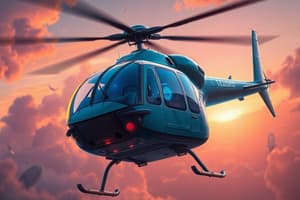Podcast
Questions and Answers
Which force opposes thrust during flight?
Which force opposes thrust during flight?
- Thrust
- Weight
- Drag (correct)
- Lift
What occurs when the angle of attack exceeds the critical point?
What occurs when the angle of attack exceeds the critical point?
- Decrease in lift (correct)
- Increase in lift
- No effect on lift
- Forward motion decreases
Which principle describes the relationship between pressure and airflow over a wing?
Which principle describes the relationship between pressure and airflow over a wing?
- Newton's First Law
- Archimedes' Principle
- Bernoulli's Principle (correct)
- Conservation of Energy
What role does the center of gravity play in flight stability?
What role does the center of gravity play in flight stability?
Which control surface is responsible for controlling pitch?
Which control surface is responsible for controlling pitch?
What happens during a stall?
What happens during a stall?
How does airspeed influence lift during different phases of flight?
How does airspeed influence lift during different phases of flight?
What is indicated by a high lift-to-drag ratio?
What is indicated by a high lift-to-drag ratio?
What is the primary purpose of flaps during flight?
What is the primary purpose of flaps during flight?
Which factor influences directional stability in an aircraft?
Which factor influences directional stability in an aircraft?
What occurs when there is an excessive angle of attack during flight?
What occurs when there is an excessive angle of attack during flight?
Which type of lift is generated while the airplane is in motion?
Which type of lift is generated while the airplane is in motion?
What do the ailerons on an aircraft primarily control?
What do the ailerons on an aircraft primarily control?
What describes the lift-to-drag ratio's significance in aviation?
What describes the lift-to-drag ratio's significance in aviation?
What happens during the takeoff phase of a flight?
What happens during the takeoff phase of a flight?
Which force acts downward on an aircraft due to gravity?
Which force acts downward on an aircraft due to gravity?
Flashcards are hidden until you start studying
Study Notes
Flight Principles
-
Four Forces of Flight
- Lift: Upward force that counteracts weight; generated by wings due to airfoil shape.
- Weight: Downward force due to gravity acting on the airplane's mass.
- Thrust: Forward force produced by engines; propels the aircraft.
- Drag: Resistance force that opposes thrust; caused by air friction and shape.
-
Bernoulli's Principle
- Explains how lift is created.
- Faster air movement over the wing reduces pressure, generating lift.
- Pressure differential between the upper and lower wing surfaces results in upward force.
-
Newton's Third Law of Motion
- For every action, there is an equal and opposite reaction.
- Thrust produced by engines pushes air backward, generating lift and forward motion.
-
Angle of Attack
- The angle between the chord line of the wing and the oncoming airflow.
- Increasing the angle of attack increases lift up to a critical point; beyond that, lift decreases due to stall.
-
Stall
- Condition when air flow separates from the wing surface; causes loss of lift.
- Recognized by a sudden drop in altitude and often accompanied by a warning sound in modern planes.
-
Airspeed
- Crucial for generating lift; varies during different phases of flight (takeoff, cruising, landing).
- Minimum control speed is essential for stability and control.
-
Control Surfaces
- Ailerons: Control roll; located on the wings.
- Elevators: Control pitch; located on the tail.
- Rudder: Controls yaw; also located on the tail.
-
Center of Gravity
- The point where an aircraft's weight is evenly distributed.
- Affects stability; must be within specified limits for safe flight.
-
Stability and Control
- Static stability: The initial response to a disturbance.
- Dynamic stability: The system's response over time.
- Longitudinal, lateral, and directional stability are critical for safe maneuvers.
-
Lift-to-Drag Ratio
- Indicates the efficiency of an aircraft; higher ratios indicate better aerodynamic performance.
- Influences the design and performance during flight operations.
Four Forces of Flight
- Lift: Upward force that counteracts weight; generated by wings due to airfoil shape.
- Weight: Downward force due to gravity acting on the airplane's mass.
- Thrust: Forward force produced by engines; propels the aircraft.
- Drag: Resistance force that opposes thrust; caused by air friction and shape.
Bernoulli's Principle
- Explains how lift is created.
- Faster air movement over the wing reduces pressure, generating lift.
- Pressure differential between the upper and lower wing surfaces results in upward force.
Newton's Third Law of Motion
- For every action, there is an equal and opposite reaction.
- Thrust produced by engines pushes air backward, generating lift and forward motion.
Angle of Attack
- The angle between the chord line of the wing and the oncoming airflow.
- Increasing the angle of attack increases lift up to a critical point; beyond that, lift decreases due to stall.
Stall
- Condition when air flow separates from the wing surface; causes loss of lift.
- Recognized by a sudden drop in altitude and often accompanied by a warning sound in modern planes.
Airspeed
- Crucial for generating lift; varies during different phases of flight (takeoff, cruising, landing).
- Minimum control speed is essential for stability and control.
Control Surfaces
- Ailerons: Control roll; located on the wings.
- Elevators: Control pitch; located on the tail.
- Rudder: Controls yaw; also located on the tail.
Center of Gravity
- The point where an aircraft's weight is evenly distributed.
- Affects stability; must be within specified limits for safe flight.
Stability and Control
- Static stability: The initial response to a disturbance
- Dynamic stability: The system's response over time.
- Longitudinal, lateral, and directional stability are critical for safe maneuvers.
Lift-to-Drag Ratio
- Indicates the efficiency of an aircraft; higher ratios indicate better aerodynamic performance.
- Influences the design and performance during flight operations.
Four Forces of Flight
- Lift: The upward force that counteracts the aircraft's weight, generated by the wings as air flows over and under them
- Weight: The downward force due to gravity acting on the aircraft's mass
- Thrust: The forward force produced by the engines to propel the airplane
- Drag: The resistance force opposing thrust, including friction and pressure differences
Bernoulli's Principle and Angle of Attack
- Bernoulli's Principle: Explains how lift is generated by differences in airflow velocity; faster airflow over the wing creates lower pressure above, causing lift
- Angle of Attack (AoA): The angle between the wing's chord line and the oncoming air; increasing AoA can increase lift but also drag and risk of stall
Stall
- Occurs when airflow separates from the wing's upper surface, resulting in a dramatic loss of lift, characterized by a sudden drop in altitude and potential increase in drag
Control Surfaces
- Ailerons: Control roll by adjusting wing movement, located on the outer wings
- Elevators: Control pitch by adjusting the horizontal stabilizer
- Rudder: Controls yaw by adjusting the vertical stabilizer
- Flaps: Extend during takeoff/landing to increase lift at lower speeds
Center of Gravity (CG) and Stability
- Center of Gravity (CG): The point where the aircraft’s mass is balanced; critical for stability and control
- Longitudinal Stability: Stability about the lateral axis; affected by the location of the CG
- Directional Stability: Stability about the vertical axis; influenced by the height of the vertical stabilizer
- Lateral Stability: Stability about the longitudinal axis; provided by wing dihedral and the design of the aircraft
Lift-to-Drag Ratio
- A measure of the aircraft's efficiency; higher ratios indicate better performance; essential for optimizing range and fuel efficiency during flight
Types of Lift
- Static Lift: Generated at a stationary position (e.g., during takeoff)
- Dynamic Lift: Generated while the airplane is in motion
Takeoff and Landing
- Takeoff: Requires reaching a minimum speed for sufficient lift; carefully managing thrust, lift, drag, and weight
- Landing: A controlled descent requiring gradual adjustment of all four forces to maintain stability and slow down the aircraft
Studying That Suits You
Use AI to generate personalized quizzes and flashcards to suit your learning preferences.



